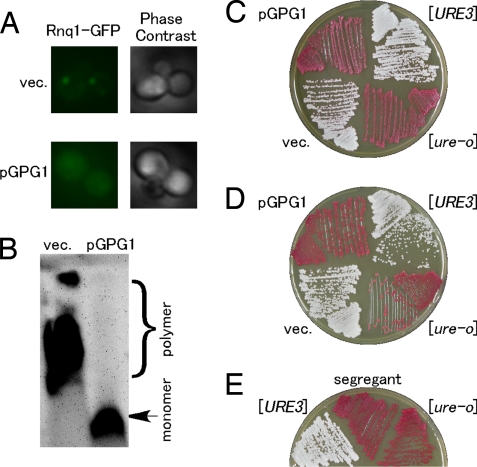Fig. 2.
Elimination of [PIN+] and [URE3] prions by over-expression of Gpg1. (A) The [PIN+] strain (NPK200 [psi−]) was transformed with pGPG1 or an empty vector (vec.), and transformants were again transformed with pRS414CUP1p-Rnq1-GFP to visualize the [PIN+] or [pin−] state with Rnq1-GFP fusion protein. Rnq1-GFP expression under the control of the CUP1 promoter was induced by 50-μM CuSO4 for 6 h in liquid SC culture. Right and left panels show phase contrast image and fluorescent image of Rnq1-GFP, respectively. (B) Effect of pGPG1 on SDS-stable Rnq1 polymers in [PIN+] cells. NPK200 ([PIN+]) cells transformed with pGPG1 or an empty vector were harvested and lysed, and equal amounts of total protein from lysates were analyzed by SDD-AGE (1% SDS). Rnq1 was detected by immunoblotting using polyclonal rabbit anti-Rnq1 antibody. (C) [URE3] elimination by Gpg1 in the [pin−] state. The [URE3] [pin−] (NPK302) strain was transformed with pGPG1 or an empty vector, and the [URE3] state was monitored by the ADE2 color assay (23). In brief, the protein determinant of [URE3], Ure2, is a negative regulator of the transcription factor Gln-3 that activates the DAL5 promoter. The indicated reporter contains the ADE2 gene under the control of DAL5 promoter. A [ure-o] strain has active Ure2, which prevents ADE2 transcription and gives rise to red colonies on YPD. A [URE3] strain has inactive Ure2, which allows for ADE2 transcription and gives rise to white colonies on YPD. (D) [URE3] elimination by Gpg1 in the [PIN+] state with strain NPK304 ([URE3], [PIN+]). (E) Complete curing of [URE3] after segregation of the pGPG1 plasmid as per details described in Fig. 1C. Reproducibility was confirmed in 3 independent segregants.

